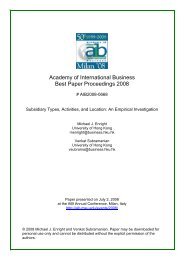AIB 2012 Conference Proceedings - Academy of International ...
AIB 2012 Conference Proceedings - Academy of International ...
AIB 2012 Conference Proceedings - Academy of International ...
Create successful ePaper yourself
Turn your PDF publications into a flip-book with our unique Google optimized e-Paper software.
TUESDAY<br />
study and to provide samples <strong>of</strong> teaching tools and assignments intended to improve cultural literacy. (For more<br />
information, please contact: Mikelle A. Calhoun, Georgia Southern University, USA: pr<strong>of</strong>.calhoun@gmail.com)<br />
Session: 3.2.13 - Interactive<br />
Track: 2 - Marketing and Supply Chain<br />
Export Performance, Branding, and Retailing<br />
Presented On: July 3, <strong>2012</strong> - 10:45-12:00<br />
Chair: Yupin Patara, Chulalongkorn University<br />
Export Diversification and Firm Performance: Why and How Does Export Intensity Matter<br />
Dirk Michael Boehe, Insper Institute <strong>of</strong> Education and Research<br />
This study develops a theory that seeks to explain the relationship between export diversification and firm<br />
performance under varying degrees <strong>of</strong> foreign over total sales (export intensity). By integrating conceptual<br />
building blocks from corporate diversification strategy, international marketing and the country-<strong>of</strong>-origin effect,<br />
we develop a three-stage theory that suggests a declining S-curve relationship between geographic export<br />
diversification and firm performance if exporters' export intensity is low and an inverted U-shape if export<br />
intensity is high. We examine our hypothesis using a panel <strong>of</strong> longitudinal archival data with roughly 2,000 firmyear<br />
observations, which cover all <strong>of</strong> the possible export destination countries served by large Brazil-based<br />
exporters from 2001 to 2009. Our results imply that the degree to which the country <strong>of</strong> origin's institutional,<br />
economic and market environments affect its exporters is paramount to understanding why the relationship<br />
between geographic diversification and performance varies. (For more information, please contact: Dirk Michael<br />
Boehe, Insper Institute <strong>of</strong> Education and Research, Brazil: dirkmb@insper.edu.br)<br />
Conflicts and Export Performance: The Role <strong>of</strong> Company Specific Factors<br />
Gregor Pfajfar, University <strong>of</strong> Ljubljana<br />
Maja Makovec Brencic, University <strong>of</strong> Ljubljana<br />
Aviv Shoham, University <strong>of</strong> Haifa<br />
While the relationships between conflict and export performance have been studied, the findings have been<br />
equivocal. We argue that conflicts have impact on objective performance measures (financial and strategic<br />
performance), which further impact subjective measures (satisfaction with export venture). The empirical<br />
results among 105 exporters show that conflicts have impact on export performance only when the company is<br />
large, operating on many markets and coming from a high-tech industry. Reasons for somehow surprising<br />
results we may find in the concept <strong>of</strong> organizational inertia and the fact that SMEs are much more flexible and<br />
changing faster than large companies, while conflicts need time to arise. (For more information, please contact:<br />
Gregor Pfajfar, University <strong>of</strong> Ljubljana, Slovenia: gregor.pfajfar@ef.uni-lj.si)<br />
Market Orientation in Chinese Retailer-Supplier Relationship: The Reference Group Perspective<br />
Brenda Sternquist, Michigan State University<br />
Jing Zhao, Michigan State University<br />
Retailing evolves in developing economies as the nature <strong>of</strong> buyer-supplier relationships changes. At early stages<br />
<strong>of</strong> the development, manufacturers are given full range to determine what merchandise a retailer will <strong>of</strong>fer.<br />
Retailers serve essentially as manufacturer's showrooms. In such circumstance, market orientation will not<br />
occur. With economic development retailers begin to play a more important role in merchandise selection and<br />
strategic positioning <strong>of</strong> the <strong>of</strong>fering. BRIC countries are at this stage. This study investigates market orientation<br />
<strong>AIB</strong> <strong>2012</strong> <strong>Conference</strong> <strong>Proceedings</strong><br />
Page 215

















